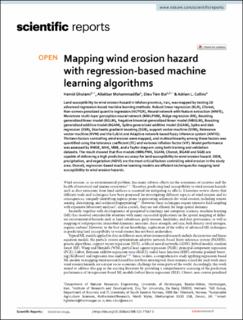| dc.identifier.citation | Gholami, H., Mohammadifar, A., Bui, D. T. & Collins, A. L. (2020). Mapping wind erosion hazard with regression-based machine learning algorithms. Scientific Reports, 10, 20494. | en_US |
| dc.description.abstract | Land susceptibility to wind erosion hazard in Isfahan province, Iran, was mapped by testing 16 advanced regression-based machine learning methods: Robust linear regression (RLR), Cforest, Non-convex penalized quantile regression (NCPQR), Neural network with feature extraction (NNFE), Monotone multi-layer perception neural network (MMLPNN), Ridge regression (RR), Boosting generalized linear model (BGLM), Negative binomial generalized linear model (NBGLM), Boosting generalized additive model (BGAM), Spline generalized additive model (SGAM), Spike and slab regression (SSR), Stochastic gradient boosting (SGB), support vector machine (SVM), Relevance vector machine (RVM) and the Cubist and Adaptive network-based fuzzy inference system (ANFIS). Thirteen factors controlling wind erosion were mapped, and multicollinearity among these factors was quantified using the tolerance coefficient (TC) and variance inflation factor (VIF). Model performance was assessed by RMSE, MAE, MBE, and a Taylor diagram using both training and validation datasets. The result showed that five models (MMLPNN, SGAM, Cforest, BGAM and SGB) are capable of delivering a high prediction accuracy for land susceptibility to wind erosion hazard. DEM, precipitation, and vegetation (NDVI) are the most critical factors controlling wind erosion in the study area. Overall, regression-based machine learning models are efficient techniques for mapping land susceptibility to wind erosion hazards. | en_US |

